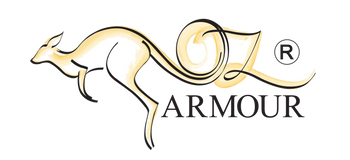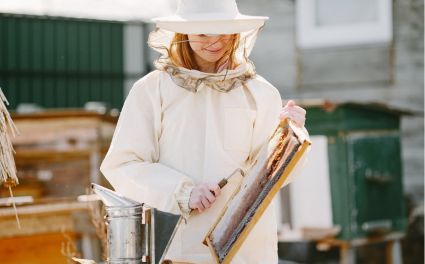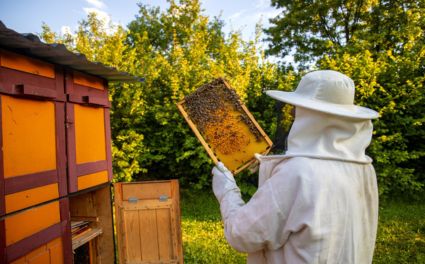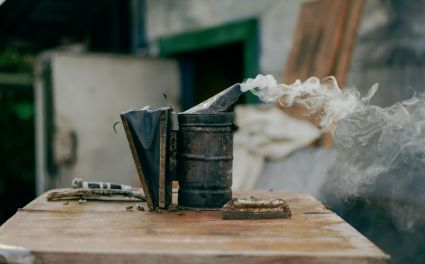The honey bees queen is the heart and soul of every thriving colony. Her strength, fertility, and pheromones dictate the hive’s productivity and behavior. For beekeepers, understanding how to identify, protect, and care for the queen is one of the most critical skills. In this comprehensive guide, we’ll explore how to recognize her, monitor her health, and support her through proper hive management and protective practices.
The Role of the Queen Bee
In a colony of thousands of honey bees, the queen has one primary purpose — reproduction. She is the only fertile female in the hive and can lay up to 2,000 eggs per day during peak season. Her continuous laying sustains the worker bee population that performs every vital task: foraging, nursing, guarding, and building combs.
Beyond egg laying, the queen produces pheromones that influence the colony’s unity and mood. These chemical signals regulate worker behavior, maintain social harmony, and even suppress the development of new queens.
For a deeper understanding of colony behavior and hive structure, beekeepers can explore guides at Learn Beekeeping — an excellent resource for improving hive management skills and understanding the intricate lives of bees.

Identifying the Queen Bee
Spotting the queen can be tricky, especially in a busy hive buzzing with activity. However, once you know what to look for, she becomes easier to find.
Physically, the queen stands out. Her abdomen is long and slender, extending past her wings. She also has a shiny thorax without the dense hair that covers worker bees. Her wings appear shorter, and her body shape is more tapered.
Behaviorally, the queen moves calmly and purposefully, often surrounded by a circle of attendants that feed and groom her. This group, called her retinue, helps her stay nourished and clean while spreading her pheromones throughout the hive.
During inspections, wearing high-quality beekeeping suits ensures safety and focus. OZ Armour’s durable suits combine sting protection with ventilation, allowing beekeepers to work comfortably. You can explore their premium Beekeeping Suits designed for long hours in the apiary.
Why a Healthy Queen Bee Matters
A productive queen is the backbone of a strong hive. Her health directly affects honey yield, population growth, and even the colony’s temperament. When she is healthy and active, you’ll notice a calm colony and consistent brood patterns.
Signs of a Healthy Queen
-
Dense, uniform brood across multiple frames
-
Regular pattern of eggs and capped brood
-
Active, calm worker behavior
-
Shiny, well-shaped body without deformities
If the queen becomes weak, the brood pattern turns patchy, and the hive may begin preparing to replace her. Requeening at the right time ensures continued productivity and colony stability.
During hive checks, wearing reliable beekeeping jackets and veils helps keep bees calm and prevents accidental stings. OZ Armour’s protective gear, like the Beekeeping Jackets, offers comfort and security for both new and experienced beekeepers.
How to Care for the Queen Bee
Caring for the queen means managing both her environment and the colony that supports her.
1. Regular Hive Inspections
Conduct routine checks to observe her egg-laying pattern and overall activity. Look for signs of disease, pests, or irregular brood. A strong queen produces eggs in a tight, consistent pattern — a sign of stability within the colony.
When working up close with frames, use beekeeping gloves that balance dexterity with safety. Protective leather or ventilated designs, like those in OZ Armour’s Beekeeping Gloves, allow for smooth handling of tools and hive components.
2. Maintain Proper Nutrition
A queen thrives in a well-fed hive. Ensure worker bees have access to nectar, pollen, and supplemental feed during times of scarcity. When workers are nourished, they can better feed the queen with royal jelly and maintain optimal brood conditions.
3. Ensure Hive Stability
Temperature and moisture levels play a major role in queen health. Excess humidity can damage brood and lower egg viability. Keep the hive ventilated and sheltered from extreme weather.
Protecting your lower body with beekeeping trousers ensures full coverage during prolonged inspections. Breathable, sting-resistant options are available in the Beekeeping Trousers range, offering safety and flexibility.
Common Queen Bee Issues and How to Fix Them
Even in healthy colonies, queen-related problems can arise. Recognizing them early can save the hive.
Disease and Pests: Conditions like Varroa mites and Nosema infections can weaken the queen and reduce her fertility. Regular inspections and early treatments are vital.
Poor Mating: A poorly mated queen will lay infertile eggs, leading to a drone-heavy population and eventual colony collapse. In this case, replace her with a well-mated queen.
Aging: Most queens remain productive for two years. Beyond that, egg-laying capacity drops. Requeening every two seasons helps maintain strong brood cycles.
During replacements or requeening, protect your legs and feet using beekeeping ankle protection to prevent bees from entering through cuffs or boots. You can find suitable designs under Beekeeping Ankle Protection.
Replacing and Introducing a New Queen
Replacing a queen is a delicate task that requires patience and timing. When introducing a new queen, use a queen introduction cage to allow the colony to adjust to her pheromones gradually.
Observe the hive over the next few weeks for signs of acceptance — calm worker behavior, new eggs, and organized brood are good indicators.
If young beekeepers are involved, prioritize their safety with beekeeping kids suits. These suits are lightweight, breathable, and designed for full protection. View safe, child-friendly options in Beekeeping Kids Suits.
Expanding Your Beekeeping Knowledge
A skilled beekeeper knows that understanding bees goes beyond hive inspections. Explore insightful reads like Read More Blogs About Beekeeping to learn about topics such as bumblebee vs honeybee, bee nest vs wasp nest, and the difference between a beehive and a wasp nest.
Other helpful reads include how to safely remove a bee sting, identifying bumblebee vs carpenter bee, and answering common questions such as do bee suits protect from wasps? These topics are essential for improving both safety and understanding of bee behavior.
For those who enjoy adding color and comfort to their protective gear, pink bee suits are an increasingly popular choice among modern beekeepers. They combine full sting protection with a distinctive look — available in Pink Beekeeping Apparels.

Using the Right Beekeeping Equipments
Proper tools make hive management easier and safer for both the beekeeper and the bees. Smokers, hive tools, and feeders play a crucial role in calm and efficient inspections. Explore high-quality tools and accessories under Beekeeping Equipments to keep your operations organized and effective.
These tools, paired with the right protective clothing, ensure every inspection supports both the queen’s productivity and the hive’s long-term health.
Conclusion
The queen bee is the living pulse of the hive — her presence ensures growth, order, and harmony among thousands of honey bees. Learning to identify, protect, and care for her is fundamental to successful beekeeping.
With proper hive management, regular monitoring, and reliable protective gear from trusted providers like OZ Armour, beekeepers can create conditions where queens — and their colonies — flourish.
Remember: a healthy queen leads a healthy hive. Give her the care she deserves, stay equipped with dependable gear, and continue learning about the fascinating lives of bees through dedicated resources and hands-on experience.




